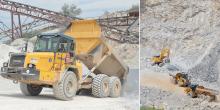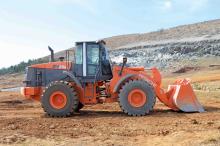With its close proximity to the central business district of Gaborone, PPC’s Kgale quarry is riding the wave of construction activity in Botswana’s capital, which is premised on the country’s sustained, and now accelerated, modernisation drive. Munesu Shoko reports.
On the back of greater political stability, good governance and prudent economic and natural resource management, Botswana’s sustained economic growth, averaging 5% per annum over the past decade, according to the
While the heavy reliance on commodities has previously rendered the country vulnerable to international market fluctuations, it has also acted as a wakeup call for the government which has now realised that it cannot rely on diamonds forever. The Botswana government has since introduced an economic stimulus programme to capacitate its economic diversification agenda. This initiative is ensuring that the economy is firing on all cylinders, with construction, all the way from road infrastructure to new property developments, being considered a key economic enabler.
On the back of this modernisation drive, Botswana is building more sophisticated highways, complemented by shopping malls that are leaping out of former dumpsites and swathes of bush. Gaborone, the capital, is expanding as far as the nearby town of Mogoditshane, and has even reached the boundaries of neighbouring Tlokweng. The country’s economy is thus expected to grow by an estimated 4.2% in 2017 compared with the 2.9% growth in 2016.
Amid such a hive of construction activity, PPC Aggregates, one of the largest providers of materials and solutions in Africa, is seeing increased demand for aggregates at its Kgale quarry, strategically located some 3km from Gaborone city centre. PPC Aggregates Botswana is the biggest aggregates producer in Botswana. As part of its African expansion programme, the South African-headquartered company acquired three more aggregate quarries from Quarries of Botswana way back in 2011, to add to its existing Kgale quarry. The US$6.8 million acquisition for new quarries in Gaborone, Francistown and Selebi-Phikwe, was driven by the company’s foresight that both Gaborone and Francistown were going to be significant growth drivers in Botswana.
Rightly so, construction activity abounds in Gaborone, and PPC’s Kgale quarry has expanded its existing plant to be able to cope with the increasing demand of its aggregates. Aggregates Business International recently visited the quarry, which supplies an extensive range of granite products to the civil construction industry, including large construction concerns, as well as readymix concrete producers, brick manufacturers and road construction projects.
Its grey granite product range includes 19mm for road stone and concrete production; 13.2 mm; 9.5mm; 6.7mm; as well as crusher dust. According to Patrick Lesola, works manager, PPC Aggregates Botswana, the quarry faces a “nice problem to have” of increased demand, which at some point, exceeds the available supply capacity of 600,000tonnes/year. The setback has since been plugged by establishing Plant 2 on site, which produces about 100tonnes/hour, and has the same structure as the main plant.
To meet the increased demand, the quarry also works on a 24/5 basis from Monday to Friday, working three shifts a day. In terms of operational processes, several of the activities at Kgale are subcontracted. Drilling and blasting has been outsourced to contractor, Nowata Africa. Nowata Africa has since subcontracted the drilling function to Danoher Contracting, which has an
Lesola reasons that outsourcing these processes leads to a combination of downsizing the company’s fixed costs and reducing capital investments. However, he is of the view that when you outsource several processes of your operation, contractor management becomes extremely crucial.
For example, quarry management doesn’t stipulate frequency of the drill and blast processes, but the contractor has been tasked with providing an average of 65,000tonnes of rock-on-ground every month. Frequency of blasts is dictated by available demand. “We buy capacity from them,” says Lesola.
After the blasts, material is hauled from the pit to the primary crusher using three
The fewer passes that are made result in shorter cycle times, which in turn increase production, while reducing diesel burn, which is about 25,000 litres per month, contributed mostly by the combustion of explosives on site. With that in mind, a 50 tonne
Haulers tip directly into the primary crusher, a
Plant 2 is fed with material already processed from the primary crusher of the main plant. Material is hauled from the primary crusher to Plant 2 using a 20 t Bell ADT, which is loaded by a
Three Bell front-end loaders – L2208C, 2606D and 2606E models – are loading customer trucks at the stockpiles. A
For a busy quarry of this nature, any form of downtime is out of the question. A strict service and maintenance regime keeps all critical machinery in working order. Because of the strict production timelines, both the main plant and Plant 2 have no complete shutdown periods. One part of the plant is serviced at a time, while the other parts remain operational. During busy periods, periodical service and maintenance of plant can be done during weekends when the quarry is not operational.
An aggregate plant may sound the easiest business for anybody to run, especially with its low barriers to entry. But, Lesola notes that a key challenge for any operation of this nature is to be able to match production with market demand. In this regard, production flexibility is vital. “The ability to be able to increase certain products as the market requires them or decrease as demand goes down to keep the balance, is very important,” he says.
However, to accommodate that flexibility remains a challenge. Equipment is expensive while margins are very low, and this is exacerbated by the fact that aggregate is already a low margin material.
To address this challenge, Kgale quarry invested in Plant 2, which is working on a two-shift basis, and has the flexibility to work the maximum of three shifts when required.
Lesola also reasons that keeping control of costs is another key challenge, especially in an environment where power prices are going up and it is very difficult to pass on the charges to the market. “For us, controlling input costs remains a big focus as aggregate is a low-margin business,” reasons Lesola, adding that at least the increased demand and little competition in the proximity of the quarry help offset some of these challenges.









